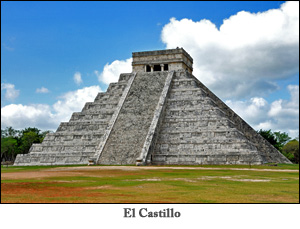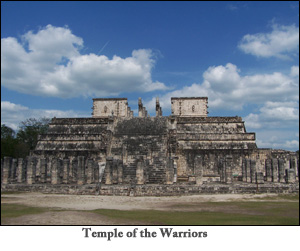 A trip to Mexico often takes the Western traveler to the tourist hotspot of Cancun. While there are those who will happily while away a holiday on the beach and in the bars, only a short journey away by bus is the pre-Hispanic city of Chichen Itza.
A trip to Mexico often takes the Western traveler to the tourist hotspot of Cancun. While there are those who will happily while away a holiday on the beach and in the bars, only a short journey away by bus is the pre-Hispanic city of Chichen Itza.
Offering a glimpse into life for the indigenous Mayan people who lived in Mexico over 1,500 years ago, this UNESCO world heritage site has some spectacular sights for anyone who has an interest in this fascinating time in human history.
The first thing you’ll see on arrival at the site from the main entrance to complex is El Castillo, a 98 ft (30 m) high step-pyramid built in honor of the feathered serpent god Kukulcan. On the spring and autumn equinoxes, the late afternoon sunlight casts a shadow down the north-west corner of the pyramid to the carved serpent head at the bottom, lending it the appearance of a serpent slithering down the steps.
The site has a number of ball courts in which a popular Mesoamerican ballgame would have been played to entertain the people of the city. The largest of these is the vast Great Ball Court, measuring 551 ft x 229 ft (168 m by 70 m), is surrounded by 8m high walls carved with figures of ball players. At the end of the ball court is the North Temple and yet more temples built into the east walls and entrance to the ball court. These temples have well-preserved carvings that depict great battles and show further devotion to the feathered serpent El Castillo was built to honor.
 The Temple of Warriors cuts an imposing figure in the complex, with a large stepped pyramid and carved columns depicting marching warriors flanking its walls. The Temple encases an older structure, the Temple of Chac Mool – a fertility god whose recumbent figure can be seen all across the Chichen Itza site.
The Temple of Warriors cuts an imposing figure in the complex, with a large stepped pyramid and carved columns depicting marching warriors flanking its walls. The Temple encases an older structure, the Temple of Chac Mool – a fertility god whose recumbent figure can be seen all across the Chichen Itza site.
Moving away from the first area you come across when entering the site, there is plenty more for you to explore. The collection of temples and other structures referred to as the Central Group includes amongst the buildings some of the most important structures in the Puuc architectural style.
One of these, El Caracol – so called for its round central tower giving it the resemblance of a snail – is thought to have been an ancient observatory, with doors and windows aligned in such a way that the progress of Venus’ path across the sky could be followed by astrologers.
When visiting the site, it’s very easy to engage a tour guide who can talk you through the key sights and fill you in on the history of the area. There will be a guide who can speak just about any language imaginable and tours leave regularly from the main gates.
Your entrance ticket is valid all day, and if you decide to engage a guide you will have plenty of time to explore Chichen Itza at leisure once you’ve been given an introduction. Although the main complex of structures, where El Castillo and the Great Ball Court are located, are very open and exposed to the heat of the day, there are plenty of places to seek shelter from the sunshine and get a drink or something to eat.
To make the most of your visit, it pays to get to the site as early as you can. Once it reaches midday, it can be uncomfortably hot walking around the monuments and you will want to take shelter and wait for sun to lose some of its ferocity. Overall, the site is very well worth a visit and offers some sights you will see nowhere else in the world.
About the author: Zoe is a prolific author of travel articles and enjoyed bringing this article to you on behalf of the HouseTrip.com website. It is hoped that one day you can enjoy a trip to Chichen Itza and experience the heart of the Mayan empire for yourself, it makes for an amazing holiday experience.
Credits: Photos courtesy of Dennis Jarvis and Charles Pence respectively.